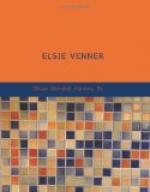On looking at the house, it was plain that it was built with Old-World notions of strength and durability, and, so far as might be, with Old-World materials. The hinges of the doors stretched out like arms, instead of like hands, as we make them. The bolts were massive enough for a donjon-keep. The small window-panes were actually inclosed in the wood of the sashes instead of being stuck to them with putty, as in our modern windows. The broad staircase was of easy ascent, and was guarded by quaintly turned and twisted balusters. The ceilings of the two rooms of state were moulded with medallion-portraits and rustic figures, such as may have been seen by many readers in the famous old Philipse house,—Washington’s head-quarters,—in the town of Yorkers. The fire-places, worthy of the wide-throated central chimney, were bordered by pictured tiles, some of them with Scripture stories, some with Watteau-like figures,—tall damsels in slim waists and with spread enough of skirt for a modern ballroom, with bowing, reclining, or musical swains of what everybody calls the “conventional” sort,—that is, the swain adapted to genteel society rather than to a literal sheep-compelling existence.
The house was furnished, soon after it was completed, with many heavy articles made in London from a rare wood just then come into fashion, not so rare now, and commonly known as mahogany. Time had turned it very dark, and the stately bedsteads and tall cabinets and claw-footed chairs and tables were in keeping with the sober dignity of the ancient mansion. The old “hangings” were yet preserved in the chambers, faded, but still showing their rich patterns,—properly entitled to their name, for they were literally hung upon flat wooden frames like trellis-work, which again were secured to the naked partitions.
There were portraits of different date on the walls of the various apartments, old painted coats-of-arms, bevel-edged mirrors, and in one sleeping-room a glass case of wax-work flowers and spangly symbols, with a legend signifying that E. M. (supposed to be Elizabeth Mascarene) wished not to be “forgot”
“When
I am dead and lay’d in dust
And
all my bones are”—
Poor E. M.! Poor everybody that sighs for earthly remembrance in a planet with a core of fire and a crust of fossils!
Such was the Dudley mansion-house,—for it kept its ancient name in spite of the change in the line of descent. Its spacious apartments looked dreary and desolate; for here Dudley Venner and his daughter dwelt by themselves, with such servants only as their quiet mode of life required. He almost lived in his library, the western room on the ground-floor. Its window looked upon a small plat of green, in the midst of which was a single grave marked by a plain marble slab. Except this room, and the chamber where he slept, and the servants’ wing, the rest of the house was all Elsie’s. She was always a restless, wandering child from her




